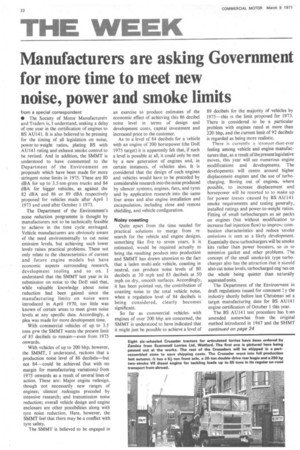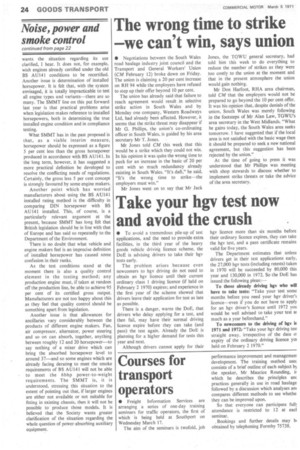Manufacturers are asking Government for more time to meet new noise, power and smoke limits
Page 24

Page 26

If you've noticed an error in this article please click here to report it so we can fix it.
from a special correspondent • The Society of Motor Manufacturers and Traders is, I understand, seeking a delay of one year in the certification of engines to ES AU141. It is also believed to be pressing for the timing of all legislation on noise, power-to-weight ratios, plating BS with AU141 rating and exhaust smoke control to be revised. And in addition, the SMMT is understood to have commented to the Department of the Environment on proposals which have been made for more stringent noise limits in 1975. These are 80 dBA for up to 3.5-ton-gross trucks and 84 dBA for bigger vehicles, as against the 82 dBA and 86 or 89 dBA respectively proposed for vehicles made after April 1 1973 and used after October 11973.
The Department of the Environment's noise reduction programme is thought by manufacturers not to be technically feasible to achieve in the time cycle envisaged. Vehicle manufacturers are obviously aware of the need environmentally to cut noise emission levels, but achieving such lower levels raises practical problems. These not only relate to the characteristics of current and future engine models but have economic aspects surrounding research, development tooling and so on. I understand that the SMMT last year in its submission on noise to the DoE said that, while valuable knowledge about noise reduction had been gained since the manufacturing limits on noise were introduced in April 1970, too little was known of certain areas to meet given noise levels at any specific date. Accordingly, a plea was made for more development time.
With commercial vehicles of up to 3.5 tons gvw the SMMT wants the present limit of 85 decibels to remain—even from 1975 onwards.
With vehicles of up to 200 bhp, however, the SMMT, I understand, reckons that a production noise level of 86 decibels—but not 84—could be achieved (but with no margin for manufacturing variations) from 1975 onwards as a result of several lines of action. These are: Major engine redesign, though not necessarily new ranges of engines; silencer redesigns preceded by intensive research; and transmission noise reduction; overall vehicle design and engine enclosure are other possibilities along with tyre noise reduction. Here, however, the SMMT feel that there may be a conflict with tyre safety.
The SMMT is believed to be engaged in an exercise to produce estimates of the economic effect of achieving this 86 decibel noise level in terms of design and development costs, capital investment and increased price to the customer.
As to a level of 84 decibels for a vehicle with an engine of 200 horsepower (the DoE 1975 target) it is apparently felt that, if such a level is possible at all, it could only be met by a new generation of engines and, in certain instances, of vehicles also. It is considered that the design of such engines and vehicles would have to be preceded by considerable research into the noise produced by silencer systems, engines, fans, and tyres and by application research into the same four areas and also engine installation and encapsulation, including close and remote shielding, and vehicle configuration.
Noisy coasting
Quite apart from the time needed for practical solutions to merge from research for the vehicle and engine designs, something like five to seven years, it is estimated, would be required actually to bring the resulting product into production and SMMT has drawn attention to the fact that a laden multi-axle vehicle, coasting in neutral, can produce noise levels of 80 decibels at 30 mph and 85 decibels at 50 mph on dry, smooth surfaces. Accordingly, it has been pointed out, the contribution of coasting noise to the total vehicle noise, when a regulation level of 84 decibels is being considered, clearly becomes significant.
So far as commercial vehicles with engines of over 200 bhp are concerned, the SMMT is understood to have indicated that it might just be possible to achieve a level of 89 decibels for the majority of vehicles by 1975—this is the limit proposed for 1973. There is considered to be • a particular problem with engines rated at more than 220 bhp, and the current limit of 92 decibels is regarded as being more realistic.
There is currently a stronger-than-ever feeling among vehicle and engine manufacturers that, as a result of the present legislative moves, this year will see numerous engine modifications and developments. The developments will centre around higher displacement engines and the use of turbocharging. Boring out of engines, where possible, to increase displacement and horsepower will be resorted to to make up for power losses caused by BS AU141 smoke requirements and testing generally, installed ratings and power-to-weight ratios. Fitting of small turbochargers as air packs on engines (but without modification to increase fuel injection flow) to improvo combustion characteristics and reduce smoke emissions is seen as a likely development. ,Essentially these turbochargers will be smoke kits rather than power boosters, so as to minimize gasket and other problems. The concept of the small smoke-kit type turbocharger also has the attraction that it should also cut noise levels, turbocharged engines on the whole being quieter than naturally aspirated units.
The Department of the Environment in draft regulations issued for comment ty the industry shortly before last Christmas set a target manufacturing date for BS AU141 engine certification of October 1 this year.
The BS AU141 test procedure has been amended somewhat from the original method introduced in 1967 and the SMMT continued on page 24 wants the situation regarding its use clarified, I hear. It does not, for example, wish engines already certified under the old BS AU141 conditions to be recertified. Another issue is determination of installed horsepower. It is felt that, with the system envisaged, it is totally impracticable to test all engine types and variants—there are so many. The SMMT line on this put forward last year is that practical problems arise when legislation makes reference to installed horsepowers, both in determining the true installed engine condition and in compliance testing.
What SMMT has in the past proposed is that, as a viable interim measure, horsepower should be expressed as a figure 5 per cent less than the gross horsepower produced in accordance with BS AU141. In the long term, however, it has suggested a more practical definition be developed to resolve the conflicting needs of regulations. Certainly, the gross less 5 per cent concept is strongly favoured by some engine makers.
Another point which has worried manufacturers about using the BS AU141 installed rating method is the difficulty in comparing DIN horsepower with BS AU141 installed. This, of course, is a particularly relevant argument at the present, because SMMT has long felt that British legislation should be in line with that of Europe and has said so repeatedly to the Department of the Environment.
There is no doubt that what vehicle and engine makers feel is an imprecise definition of installed horsepower has caused some confusion in their ranks.
As the test conditions stand at the moment there is also a quality control element in the testing method; any production engine must, if taken at random off the production line, be able to achieve 95 per cent of its certified gross output. Manufacturers are not too happy about this as they feel that quality control should be something apart from legislation.
Another issue is that allowances for ancillaries vary considerably between the products of different engine makers. Fan, air compressor, alternator, power steering and so on can absorb, together, anything between roughly 12 and 20 horsepower—to say nothing of a mixer drive which can bring the absorbed horsepower level to around 37—and so some engines which are already facing derating to meet the smoke requirements of BS AU141 will not be able to meet the 6bhp power-to-weight requirements. The SMMT is, it is understood, stressing this situation to the extent of pointing out that, if larger engines are either not available or not suitable for fitting in existing chassis, then it will not be possible to ' produce those models. It is believed that the Society wants greater clarification of the situation regarding the whole question of power-absorbing auxiliary equipment.




































































































